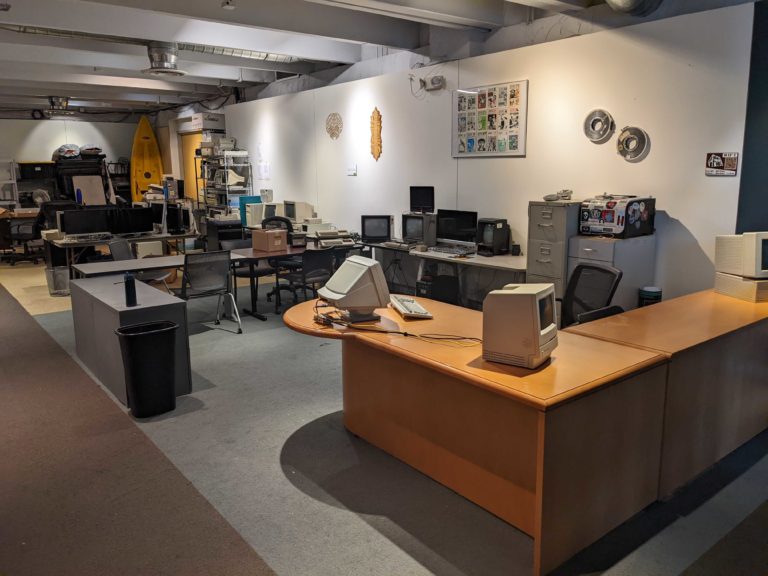Wiki
Overview
Purpose
Preserve an interactive example of the 1980’s and 1990’s computer systems for education, inspiration, and entertainment.
Thoughts
We would like to have as many systems restored and working as we have practical space to keep them stored and even setup for daily use. Machines that are repaired can be used for demonstrations, education, video games, creative works, etc. Having systems running complete with only their original era-accurate equipment is becoming more difficult as these platforms age. With the numerous systems we have adjacent to each other, there are still opportunities to demonstrate vintage home computer operation. Systems that have modernized work-around components installed at least get to add the value of functioning with their original physical appearance and hardware architecture. Keeping the original display technology (like CRTs), peripherals, and the chassis intact help portray what computer usage was like in the decades of the 80s and 90s.
Not every machine is fully functional yet. And there are different levels of effort required to restore each machine. Systems which have no hardware issues will only need software loaded and a how-to procedure for use at denhac. Software is almost always available on the internet archive or hobbyist collector websites. We are also fortunate to already have a decent collection of the original software disks for many of these systems. There are also various adapter devices available for purchase today that can transfer software to the media that a vintage machine can read (floppy disk adapters). Going away from original parts, there are after-market bus adapters that completely replace having a floppy or hard drive. For example, an SD card, which is adapted by a device to operate on the vintage machine’s original bus architecture. But some of our systems need more than software, peripherals, device cards, and bus adapters. We also have hard-to-get machines that require some circuit board rework. Twenty years ago, these failures would have usually junked these machines, but today that’s usually the expected state they will be in. These computer systems found today is often because a past collector had it repaired already. At denhac we have a space with ample electronics tools to give the opportunity to these computers with failed electronics components. So it is reasonable right now to store some of these machines until we get to working on the electronics.
History
Colorado has a history for computer data storage development. StorageTek was founded in Louisville in 1969 by IBM engineers. People, products, and companies that took part in tape and hard disk technologies still reside here. Exabyte and Spectra Logic in Boulder, ExcelStor, Conner, Maxtor in Longmont, as well as Seagate offices. Sun had offices in Broomfield, which where also VMWare has offices, Hewlett Packard has offices in Fort Collins, and Seymour Cray himself lived here in the Colorado Springs area. The technical workforce needed for storage was established in Colorado and denhac being in close proximity, in Denver, CO, will have the benefit of networking with collectors and surplus storages to locally acquire pieces that are both part of computer history and Colorado history. Therefore denhac being a non-profit org in Colorado, can help facilitate with the local resources of what may come of left over historical storage technologies. These devices can be repaired here, stored, and demonstrated as part of hacker, techie, and Colorado history.
Summary List
At denhac, we have the following hardware available for 1980-2000 with consideration for gaming:
- TI TMS9900 in the TI-99/4A
- Zilog Z80 in the Kaypro II
- MOS 6510 in the Commodore 64
- MOS 8501 in the Commodore Plus/4
- Motorola 68010 in the Amiga A1000
- Motorola 65816 in the Apple IIGS
- Motorola 68020 in the Macintosh LC for color
- Motorola 68030 in the Macintosh IIcx & LC II for color
- Motorola 68030 in the Macintosh SE/30 & Classic II for 1-bit
- PowerPC 750 in the iMac
- PowerPC 7455 in the G4
- Intel 286 (Premier)
- Intel 386 (TBD, contact for details)
- Intel 486SX (Professional Technologies Unitron)
- Intel 486DX2 (AOpen)
- Intel Pentium (Pac Bell)
- Intel Pentium II (IBM Aptiva)
- Intel Pentium III (Dell T500)
- 3dfx Glide graphics API (Voodoo 3 3000 AGP in the Dell T500)
- RealMagic graphics API (TBD, contact for details)
- Nvidia GeForce 2 graphics (TBD, contact for details)
- Nvidia GeForce 3 graphics (TBD, contact for details)
- Nvidia GeForce 4 graphics (TBD, contact for details)
- Nvidia GeForce FX graphics (TBD, contact for details)
- Anything else not listed is not yet available
Computer Systems
This a list of the vintage computer hardware we have physically available at the space. These are brief notes on each system to keep information available for the equipment we are collecting.
The available Apple Macintosh and PC systems have significantly increased and are no longer accurately tracked here.
Systems
Amiga A1000
https://en.wikipedia.org/wiki/Amiga_1000
- CPU 10 MHz upgraded 68010
- External 3.5″ Floppy Drive
- Color high-res monitor
- Floppy disk software available
- SCSI available
- Original retail packaging boxes
- External SCSI enclosure with two hard drives:
- Miniscribe model 9425S (Longmont, CO company)
- CYL: 221, HD: 1, OFFSET: 5550
- Seagate ST-225N
- Miniscribe model 9425S (Longmont, CO company)
- System collection on loan from Jax
Apple IIgs
https://en.wikipedia.org/wiki/Apple_IIGS
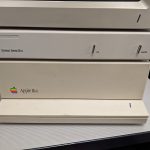
- This system is now in power failure and needs PCB diagnosing and troubleshooting!
- Four floppy disk drives available
- These are great to have since the hardware can use ZCAV disks
- Serial Communication
- We have several mini-din to DE-9 adapters for connecting external data
- https://adtpro.com/connectionsserial.html
- It is possible to boot with serial with no SCSI drive or floppy disk drive
- Aux power switch runs the 20MB SCSI hard drive
PR#7at the prompt will boot to the hard drive if it does not do so
Apple Mac LC II
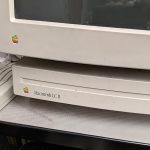
https://en.wikipedia.org/wiki/Macintosh_LC_II
- Not currently working. Does not power on.
- Similar to the Mac SE/30 (with color) for running software
Apple Mac SE/30
https://en.wikipedia.org/wiki/Macintosh_SE/30
- Just acquired Nov 2021
- Model M5119 with HD40A
- AppleCARE Sticker on back dated 09-29-92
- Has velcro attached for possible glare hood
- System not working; “Simasimac”
- There are many high quality youtube videos and blogs on how exactly to repair this
- Denhac’s screwdriver for these types of chassis are in the cabinet unit with the Apple floppy disks
- The SE/30 is the top-of-the line final product for this style of Mac with 9″ B/W CRT
- Donated by Gunner
Apple iBook G3
https://en.wikipedia.org/wiki/IBook#iBook_G3_(%22Clamshell%22)
- Missing keyboard
- Missing power supply
- Missing boards
AT&T PC 6300 Plus
https://en.wikipedia.org/wiki/Olivetti_M24
- Two systems, the Plus has a ubiquitous model of MFM hard disk, Seagate ST-225, the non-Plus is only floppy drives
- One of the best examples of a fast and expandable 8086-based (8086-2 10MHz) home computer
- 8-bit PC bus (ISA) slots and proprietary Olivetti 16-bit bus slots (not physically AT bus compatible) available
- Integrated peripherals eliminate the need for many of the usual cards but also provide the bonus of 16-bit data transfers
- Needs
- Video: 25-pin D-sub (DB-25) video signal converter or an 8-bit ISA bus EGA/VGA/CVBS card
- Keyboard
- Mouse (optional, DE-9 proto bus-mouse which gangs off the standard keyboard)
- Software: Usually runs typical “IBM Compatible” MSDOS OS and programs
- Both systems donated by Gunner
IBM XT 286
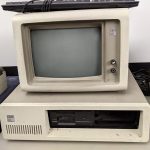
https://en.wikipedia.org/wiki/IBM_Personal_Computer_XT#IBM_XT_286
- Needs an OS disk and/or hard drive
- Currently has a loaned XT-IDE ISA-card that may need a CF-card reflash of MSDOS
- IBM 5151 MDA monochrome monitor in green
- Upgrades (not an original IBM XT 286)
- 386SX
- 4MB
- AMI 1995 BIOS
- Would be nice with an IBM keyboard such as the Model M 1391401 (or one can be loaned)
Sharkey says:
The XT was updated somewhere.. It’s running a 386SX with 4mb mem, common upgrade for those machines. American Megatrends BIOS 1995-6’ish. So for historical context it’s not a “real” XT… Good case though, we’ve even put fast 486’s in those back in the day. Kinda miss the big power switch on the side with the positive click sound to it.
Kaypro II
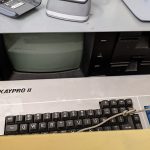
https://en.wikipedia.org/wiki/Kaypro
- Untested 8-bit computer
- Look into floppy disk formats and loading the CP/M OS
- The box of RadioShack TRS-80 floppies go to this (they both are Z80 CPU systems)
- Needs the specific impedance matched two-pair “phone-like cord” for the keyboard
- One possible candidate cable sits near it
PC Clone – Tower
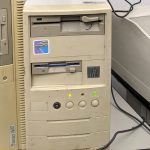
- Model BG85-V433S with AOpen badge
- Was setup at denhac at some point
- 50MHz 486DX2 skt3
- Fully loaded with hardware suitable for gaming
- Boots to DOS with extender and TSRs
- Windows 3.1, just run
winfrom DOS - Needs a serial mouse or adapter
PC Clone – Desktops
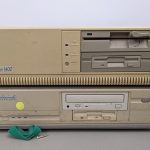
- Small Beige – Premier 286 Celebrity
- Dual 3.5″ floppy
- 525MB drive
- NiCd clock battery is leaking and starting to damage the motherboard
- Medium Beige – Professional Technologies Unitron
- 486SX-25
- 85MB drive
- CD-ROM & 3.5″ floppy drives
- Large Beige – Premier 1400
- 286 12MHz
- 45MB drive
- Needs RAM
SGI Indigo 2

- Does not have original SGI granite themed peripherals
- SUN 13W3-M to VGA adapter
- Samsung 731B 17″ LCD 5:4 aspect VGA will sync on green
- PS/2 mouse and keyboard
- Has an external SCSI port
- Boots to a working IRIX OS
- Networked through the wyse terminal raspberry pi “wysepi” NAT
- /etc/rc.local script present for network config
- 192.168.220.2, no dhcp setup
- telnet available
- Ethernet cable currently shared with the modern Linux tower next to the Decision Data
- Future plans in store for loading more software or compiling newer software
TI 99/4A
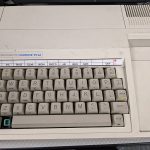
https://en.wikipedia.org/wiki/Texas_Instruments_TI-99/4A
- Now paired with the ComColor I model ACM1450 color CRT
- Missing the CTRL keycap
- Boots to the BASIC ROM as option 1
- Needs an interface for data IO so it can do more than boot the BASIC ROM interpreter
- If you write a BASIC program we currently don’t have hardware to save it to
- Retail box with the product papers
- We have two, the second one donated by Kevin Mossey
- There is a double-DIN 360K floppy drive floating around the museum that works and is known to be compatible with this
- Kevin has donated a working game cartridge for this system which is like a Pac-man clone
Toshiba Libretto
https://en.wikipedia.org/wiki/Toshiba_Libretto
- Mini Windows 95 Pentium laptop
- Untested
- Donated by Tek?
Vectrex
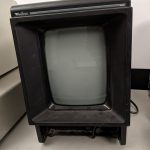
https://en.wikipedia.org/wiki/Vectrex
- The vector graphics are not fully drawn correctly
- Needs board diagnosing and repairs for the CRT control
- Do not use or else the center of the screen will get burnt-in
- On in-definite loan to denhac by the Robey family, in memory of Chuck Robey
Wyse WY55
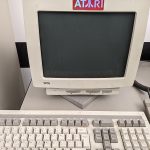
https://en.wikipedia.org/wiki/Computer_terminal
- Amber screen Terminal
- Currently setup to use with a RPi running getty and USB serial
- Runs whatever ASCII/ncurses programs that work on a Raspberry Pi
- TERM is set to VT100
- Flip on, the user was pi, the password is the same as the wifi
- Needs a keymapping cheatsheet as the layout is not standard US-101/104
Wyse WY50
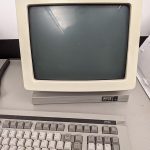
- Green screen Terminal
- Needs a serial connection to something
Acer Netbook
- Red 10″ laptop
- Atom N270 Windows XP
Gateway Laptop
- “Best Linux”
- Runs North Korea’s Linux Distro
- All networking interfaces physically blocked (guess why)
Components
- Boxes of Apple formatted floppy disks for Apple II and Macintosh
- Boxes of IBM formatted floppy disks
- Zip drive with LPT interface and zip disk media
- Jaz drive with SCSI interface and jaz cart media, with 50HD to 25D adapter
- Data Decision Dot Matrix Printer (Printronix 1986)
- Powers on with green lights
- Self-tests seem to run ok and feed paper through with print
- Using some kind of IBM AS/400 printer protocol with DB25-Centronics LPT could be possible
- Has continuous paper
- Twin Ax cables donated by Gunner
- Paper donations from Gunner and DJ
- OKI Dot Matrix Printer donated by DJ
- Genius Tablet GT-1212A for drawing input on PC 386/486 systems
- Bottero Club 90 cassette terminal probably for storing gerber code on tape to control glass cutting CNC machinery
- Lektra Labs electronic interval timer
- IBM System/360 9-track Scotch 700 data tapes in 1600 bpi format, 1960’s and 70’s stuff donated by Gunner
- Box of old CPUs and RAM donated by Gunner
- HP Jornada 560 PDA with accessories
- Sony Tektronix 314 Oscilloscope
- Samsung 731B 17″ LCDs for 5:4 aspect VGA
- 80186-based embedded card for SCSI drive testing donated by Gunner
- Xerox Y14 DUD0029A0Z02 TFT LCD (CGA, more likely proprietary print station connector) donated by Gunner
- Unknown G-1000 keyboard (feels 60’s or 70’s era) donated by Gunner
- Harris T1-4-V1 71007076-00 display adapter control board (not much else known) donated by Gunner
- Astro Engineering Teledata Coupler “Model 1-C”, Mfg April 7, 1969, in Boulder, CO (100 baud coupler modem?) donated by Gunner
- Sun Model 107 thin client August 2005, likely a SPARC processor, needs screen mount bracket repair, donated by Gunner
- Oki Microline 320 Turbo dot matrix printer (not yet tested) donated by DJ?

